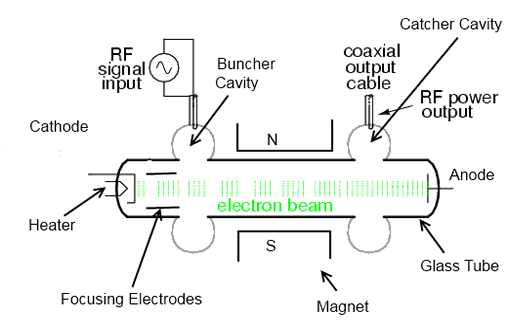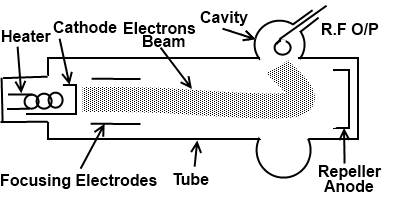Klystron
Multicavity Klystron
As shown in the given diagram. The multi cavity klystron consist of a glass envelope in which there is an electron gun composed of heater and cathode. After the electron gun there are two focusing electrodes used to keep the electron beam in the center around the glass envelope. There are two cavities known as buncher and catcher cavity. Between the cavities around the glass envelope a magnet is used in order to keep the electron beam in the center and in concentrated form at the end inside the glass envelope. There is anode used to attract the electrons emitted from the cathode.

Working of Klystron
When switch on the circuit, the electrons starts emitting from the cathode. These electrons move at a uniform speed towards the anode until they are attracted by it. Now we apply the R.F input signal to the buncher cavity with the help of loop coupling. We suppose the negative half cycle of the input signal. When this negative half cycle is applied to the buncher cavity, the negative charges will develop and the speed of electron will be reduced between the cathode and cavity. As a result the bunch of electrons will be formed near the buncher cavity. Now this bunch will travel towards the anode. At the movement when the positive half cycle is applied, the speed of electrons will increase from the previous condition. These electrons will join the bunch produced by negative half cycle and the field strength of the field of the bunch will further increase.
In this manner bunches will continue to be form. when the R.F signal is present at the buncher cavity.
when the nunch of electrons reaches in front of catcher cavity, due to its strong field strength the excitation of this cavity will take place and we will get an amplified output from the catcher cavity.
Application of Klystron
This type of klystron is mostly used for the purpose of amplification of microwave length of frequencies. it means that the high requencies can be amplified by multi cavity klystron. Which is impossible and not feasible to use other components for this purpose.
Reflex Klystron
Construction

As shown in the given diagram it is composed of heater, cathode, focusing electrodes and repeller anode. All these components are enclosed in a glass envelope. After the focusing electrodes there is a cavity resonator which encircles the glass envelope. A loop coupling is used inside the cavity to get the output.
Working
When we switch on the klystron, the heater of reflex klystron is heated up; the cathode starts emission of electrons. The focusing electrodes keep the flow of electrons in the center of glass envelope. In font of cavity resonator a huge crowed of electrons assembles and excites cavity, the oscillation it the cavity takes place and hence we get the R.F output from the cavity with the help of loop coupling.
The reflex klystron is mostly used as a microwave oscillator; it works as a local oscillator in the microwave receiver circuits. It also works as the R.F generator in the microwave transmitter circuits.
